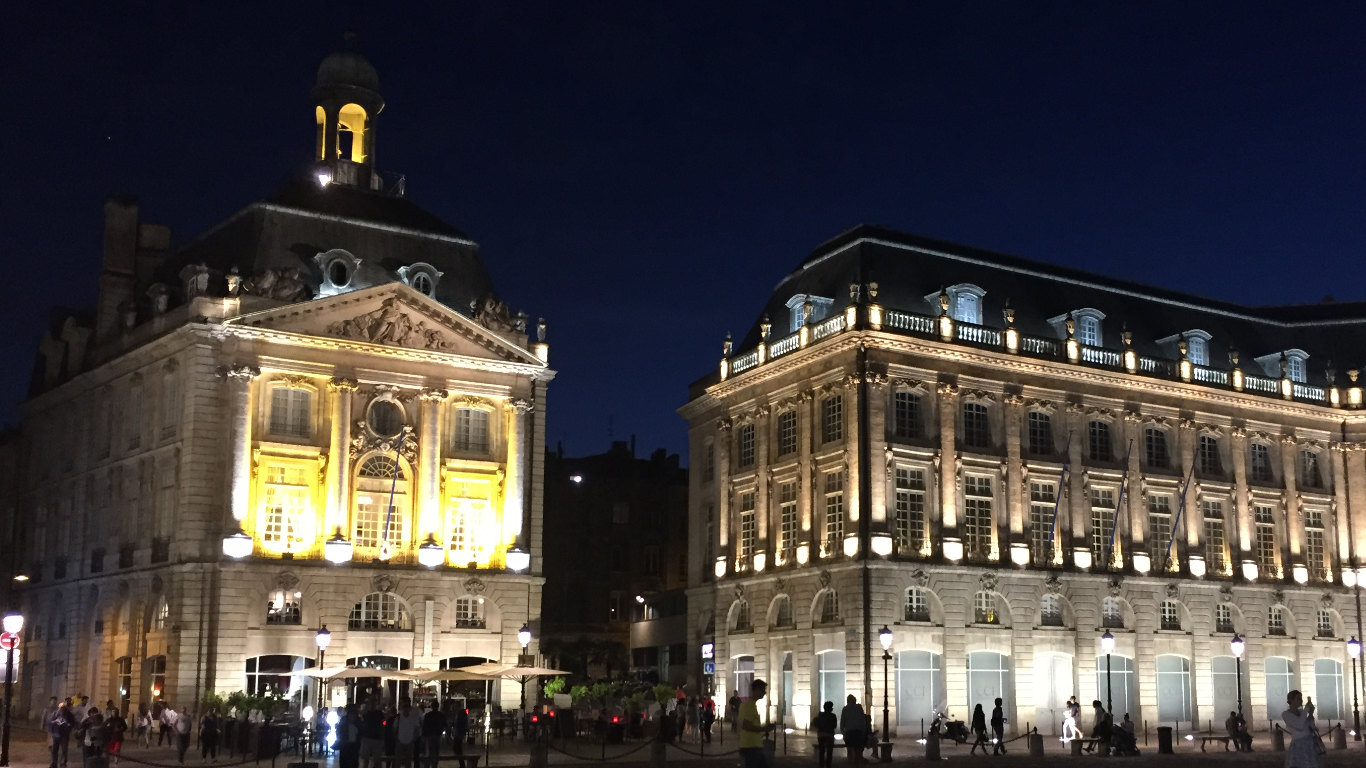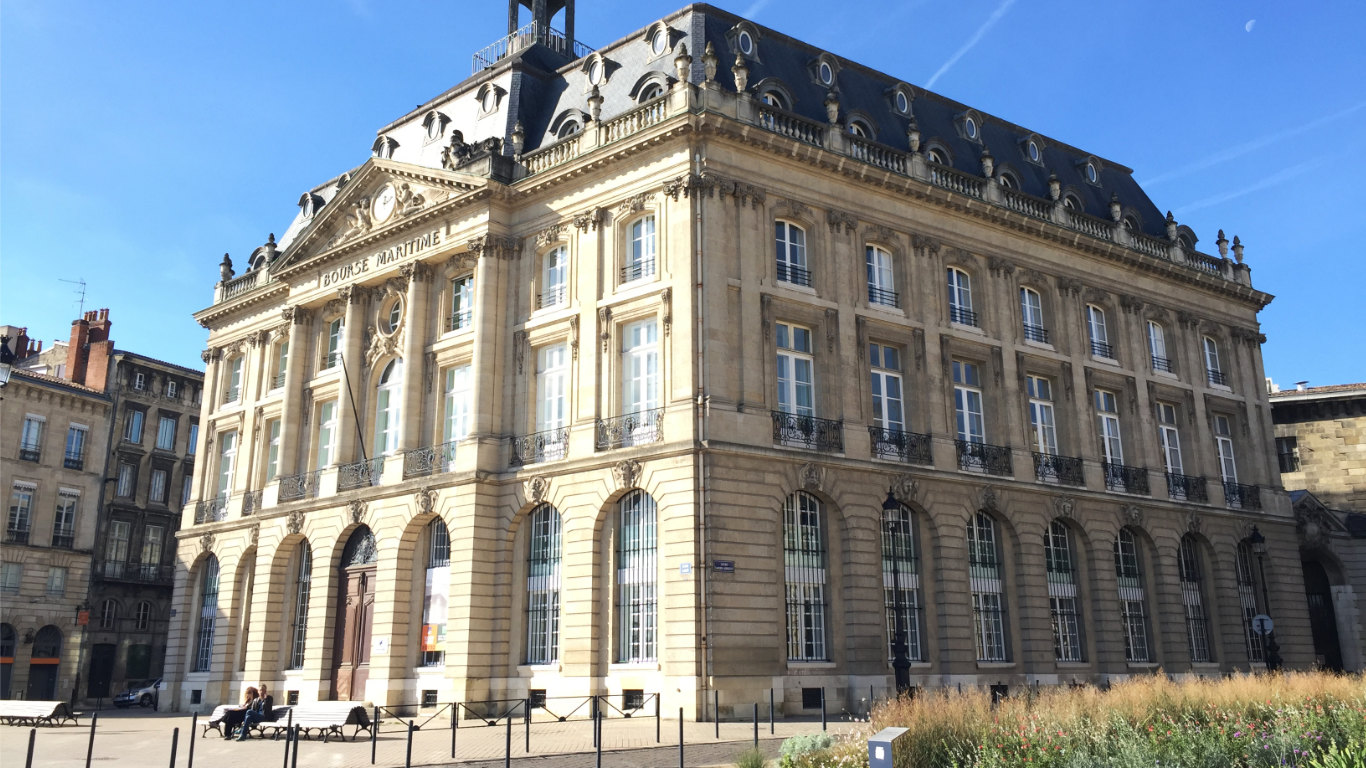
Explore Bordeaux Old Town
As the name suggests, Vieux Bordeaux or Bordeaux Old Town is the oldest part of Bordeaux. Some 150 hectares of it are UNESCO-protected and within this are about 5,000 buildings that date back to the 18th century — 350 are listed. It is a fascinating area to walk around, with its mix of grand boulevards and narrow streets, neo-classical squares, stately mansions and historic monuments.
To fully take in the sumptuous architecture of Bordeaux Old Town start by the River Garonne. Bordeaux’s now accessible riverfront is undoubtedly one of the finest in the world and a stunning site of 18th century architecture. You get the best view from the Right Bank so cross either the Pont de Pierre, and take in the vista.
Back in amongst it all, you’ll find possibly the most photographed square in Bordeaux — Place de la Bourse is framed by the river and a number of fine buildings including La Bourse (the Stock Exchange) which gives the rectangular square its name. Also around it are the former Hôtel des Fermes (customs and excise) which is now the National Customs Museum (Musée des Douanes — see What to See & Do in Bordeaux for more information).
 Place de la Bourse was designed by Louis XV’s chief architect Jacques Jules Gabriel and his son Anges-Jacques, the latter also responsible for Petit Trianon in Versailles, and Place de la Concorde and the École Militaire in Paris. It’s neoclassical style was very much of the moment and its shape, with the two side wings opening up to the river, aimed to convey both prestige and a welcome to visitors.
Place de la Bourse was designed by Louis XV’s chief architect Jacques Jules Gabriel and his son Anges-Jacques, the latter also responsible for Petit Trianon in Versailles, and Place de la Concorde and the École Militaire in Paris. It’s neoclassical style was very much of the moment and its shape, with the two side wings opening up to the river, aimed to convey both prestige and a welcome to visitors.
The facades of the buildings are decorated with mascarons (masks) — angels, carnival figures and the faces of African women which reference the city’s slave trade. These kind of decorations can be found on buildings throughout the Old Town. A statue of Louis XV on horseback was the initial focus of the square which was then called Place Royale. This was briefly replaced by that of Napoleon. The Fountain of the Three Graces which represents the three daughters of the god Zeus — the goddesses of Grace, Beauty and Mirth — dates from 1869.
Today Place de la Bourse is also famous for the Miroir d’Eau (water mirror), a 3,500 m² pool that is controlled by a complex set of computerised water circuits, transforming it from a shallow pool into a haze of spray and mist at regular intervals. Designed by renowned landscape architect Michel Corajoud, who is credited with reviving the entire waterfront, along with Jean-Max Llorca and Pierre Gangnet, the pool reflects the architecture; the effect at night, when the buildings are floodlit, is quite beautiful.
Head away from the river and into the Triangle d’Or (Golden Triangle), the heart of Bordeaux Old Town. It’s defined by three major boulevards — Cours Georges Clemenceau, Cours de l’Intendance and Allées de Tourny — that replaced the warren of medieval streets that were razed to the ground in the city’s 18th century transformation. It was here that the wealthy chose to build their mansions, in particular on Cours de l’Interdance. Today the boulevard is dominated by luxury shopping boutiques as well as chi-chi bars and cafes. It’s worth stopping off in front of number 57 — here Spanish artist Francisco Goya spent the last four years of his life after fleeing Spain. His painting ‘The Milkmaid of Bordeaux’ and the lithographic print series ‘Bulls of Bordeaux’ which depicts bullfighting were created here. When he died in 1828, aged 28, Goya’s funeral was held at the nearby Notre-Dame church and he was buried in a tomb in the Chartreuse cemetery in central Bordeaux. In 1899, his body was exhumed and transported to Spain to be buried there.
Within the three main boulevards is Place des Grands Hommes and its multi-storey glass and metal building that’s full of shops and cafes. Leading away from the Place, are roads, each of which is named after one of the great thinkers of the French Revolution — Voltaire, Rousseau and Montesquieu, hence the name ‘grands hommes’ (great men). This building is the third incarnation — the original market hall was demolished in 1958 and replaced by a concrete structure which in turn was replaced with the current one.
Allées de Tourny leads to Place de la Comedie and the Grand Théâtre that was designed by Victor Louis, also the architect of the sumptuous Comédie Française in Paris. It has a magnificent neo-classical facade with a portico of 12 Corinthian-style columns and above them 12 statues which represent the nine Muses and the goddesses Juno, Venus and Minerva. It’s now home of the Bordeaux Opera — for information see What to See & Do in Bordeaux.
Esplanade des Quinconces is the main square, and it is enormous — 126 000 square metres. Its name is due to the pattern in which its trees are planted — four trees forming a square, with a fifth in the centre. With its vast expanse of green it is where many of the city’s fairs and festivals are held. The square dates back to the 19th century, created after the 300-year-old fortified castle, Château Trompette, was demolished in 1818. The elaborate fountain, Monuments aux Girondins, was erected between 1894 and 1902, and honours the elected members of Bordeaux who were killed during the French Revolution — for more see What to See & Do in Bordeaux.
 Not far away is the Bourse Maritime or Maritime Exchange. It may look like another splendid maritime building, but it is in fact a fake! The building dates back to the early 1920s with a facade made to replicate an elegant 18th century building complete with mascarons.
Not far away is the Bourse Maritime or Maritime Exchange. It may look like another splendid maritime building, but it is in fact a fake! The building dates back to the early 1920s with a facade made to replicate an elegant 18th century building complete with mascarons.
Originally built in the 6th century, and added to in the 12th and 14th centuries, Saint Seurin basilica is the oldest churches in Bordeaux. The first stop in Bordeaux for the pilgrims followed the St James Way pilgrim route, the church is a UNESCO World Heritage site. The bell is a registered historic monument in its own right. Made from metal from weapons that were seized from the Spanish Navy during a 1637 battle, the bell was consecrated in 1640. Excavations discovered a 11th-century crypt containing tombs dating from the 4th to the 18th century; the crypt is open between 2pm – 7pm, June to September.
If you fancy seeing a bit of Roman Bordeaux, head to rue du Docteur Albert Barraud. Here you will find the ruins of Palais Gallien, a Roman amphitheatre that could seat 15,000 spectators. The amphitheatre survived until the French Revolution but parts were demolished to make way for homes. In 1800 the local authorities prevented this remaining section from being torn down; in 1911 the ruins were declared to be national heritage.
Designated a Jardin Remarquable de France (Remarkable Garden), Bordeaux’s public gardens were first created in 1746, and were originally a formal garden in typical 18th century French style. Commissioned by the Marquis de Tourny, one of the chief planners of the newly elegant city, marshland was transformed into a stately garden with three-lined avenues and flowerbeds — for more information see What to See & Do in Bordeaux.
Saint-Pierre district
For a change in mood, head for the lively St Pierre district — from Place du Parlement, heading south-east to Place Saint Pierre, Place du Palais and Place Camille-Jullian. Here is where you will find the remains of medieval Bordeaux with its narrow streets that bear the names of the professions or uses that were once here such as rue des Argentiers (goldsmiths), rue des Trois Chandeliers (candle makers) and rue du Chai des Farines (grain warehouses). Its squares are small and friendly instead of grand and imposing.
But there are stately homes too, created when the city’s medieval walls were destroyed to make way for the homes of wealthy merchants who wanted to live near the docks and their warehouses. Houses of note include 16 rue Fernand-Philippart (formerly rue Royale) – built in 1760, it has a lovely rounded balcony with magnificent curved ironwork. No. 9 rue des Faussets features a facade decorated with an ornate and beautifully-executed frieze depicting eagles. The facade of No 14 rue Argentiers features a haut-relief of a child. A niche carved into the stone at the corner of rue du Cancéra and rue des Bahutiers in 1687 has a statue of Saint Pierre – Flora Tristan, one of the first feminists and grandmother of Paul Gauguin died here. A few steps away, at no. 19 is a bas-relief called ‘The Samaritan Women at the Well’ which was carved by an unknown sculptor.
Head south towards the river and at Place du Palais you’ll find Porte Cailhau, the 15th century turreted gateway that dates back to when the city was surrounded by protective ramparts. It was built to mark a battle victory of Charles VIII and above the entrance is a niche bearing his statue. The origins of its name are unclear — it was either named after the Cailhau family, members of the Bordeaux nobility, or after the cailoux (pebbles) used as balast by ships.
One of the city’s more famous landmarks is the 15th century Grosse Cloche (Great Bell) archway. It stands on what was the Saint-Éloi gateway, the 13th century entrance to the town — see What to See & Do in Bordeaux.
The streets of St Pierre are packed with cafes, restaurants and shops, becoming less touristy, less expensive and more hip the further south you go. Place Camille Jullian is known for its independent cinema, the Utopia, in what was Saint Siméon church. The main shopping thoroughfare is Rue Saint Catherine, a 1.2 km long pedestrianised street that is packed to bursting on Saturdays.
Saint-Michel district
Continue south in Bordeaux Old Town and you come to the Saint-Michel district that surrounds the St Michel Basilica. A working-class area it was here that flat-bottomed boats unloaded their cargo of wood which went either to the carpenters’ workshops in rue Carpenteyre or the coopers in rue de la Fusterie. Other trades included blacksmiths and armourers who worked in the forges at rue des Faures. Salt used for conserving meat and fish was stored on the quai Des Salinières. The docks was a place of bartering, coarse language and ribaldry. Today St Michel is a mix of bobos (bourgeois bohemians) and immigrants, its streets and squares full of interesting small shops, cafes, bars and restaurants.
St Michel Basilica itself was started in 1350 and took two centuries to build. Beside it, but not attached, is the Flèche St Michel, the towering spire most commonly associated with Bordeaux. Built in late 15th century, the hexagonal belfry’s 114 metres high spire is the second highest in France. It’s also the place of two weekend markets — read more at What to See & Do in Bordeaux.
Nearby is the oldest bridge in Bordeaux, Pont de Pierre. It was commissioned by Napoleon Bonaparte and has 17 arches for the 17 letters in the emperor’s name. Inaugurated in 1822, it was the only bridge connecting both banks of the river for 150 years. Now it is one of five.
Photos by juseliushausammann.com.


